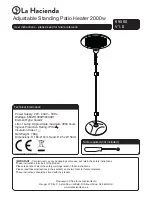
13
Heat & Glo • TIARA II-B • 7011-148 Rev. G • 10/12
NOTE:
(1) Installation requires a minimum of 6 in. (152mm)
horizontal run of vent with a 1/4 in. (6mm) rise run towards
the termination. Each 1 ft. (305mm) of horizontal venting
must include a 1/4 in. (6mm) rise. Never allow the vent
to run downward. This could cause high temperatures
and may present the possibility of a fire.
(2) The location of the horizontal vent termination on an
exterior wall must meet all local and national building
codes, and must not be easily blocked or obstructed,
see
Figure 4.4
on page 10.
(3) For installations requiring a vertical rise on the exterior
of the building, a snorkel kit is available with a 14 in.
(356mm) and a 36 in. (914mm) tall snorkel termination
cap. Follow the same installation procedures as used
for standard horizontal terminations. If the snorkel
termination must be installed below grade (i.e. basement
application), proper drainage must be provided to
prevent water from entering the snorkel termination. Do
not backfill around snorkel termination.
(4) Vertical clearances through a wall require 2 in. (51mm)
off the top of the venting pipe and 1 in. (25mm) off the
sides and bottom.
HOT
HOT
WOOD
SCREW
WALL THIMBLE
NOTES:
(1) The four wood screws provided should be replaced
with appropriate fasteners for stucco, brick, concrete,
or other types of sidings.
(2) A termination cap with a built-in vinyl standoff is highly
recommended on a building with vinyl siding. The pilot
hole will be 2 in. (51mm) closer to the bottom of the
square than the top. Using a framing square, draw a
14 in. x 14 in. (356mm x 356mm) square around the
pilot hole. See
Figure 5.7
.
8 in.
(203mm)
7 in.
(178mm)
7 in.
(178mm)
6 in.
(152mm)
Figure 5.6
Figure 5.7
Figure 5.5
CENTER
LINE
CENTER OF
HOLE
WALL
THIMBLE
CENTER
LINE
Step 3.
For installations using a round support box/wall thimble
(check pipe manufacturer's instructions), mark the wall for
a 10 in. x 10 in. (254mm x 254mm) square hole. The
center of the square hole should line up with the center line
of the horizontal pipe, as shown in
Figure 5.5
. Cut and
frame the hole in the exterior wall where the vent will be
terminated. If the wall being penetrated is constructed of
non-combustible material, i.e. masonry block or concrete,
a 7 in. (178mm) diameter hole is acceptable.
Step 4.
Position the horizontal termination cap in the center of the 10
in. x 10 in. (254mm x 254mm) square hole and run a bead
of non-hardening mastic around its outside edges, so as to
make a seal between it and the wall, attach termination cap
to the exterior wall with the four wood screws provided. The
arrow on the vent cap should be pointing up (
Figure 5.6
).
(
NOTE:
Some termination caps may cause the vent
pipe to be off center on flashing.). Ensure that proper
clearances to combustible materials are maintained. If
you are not using an approved termination cap with
a built-in standoff on a building with vinyl siding, a
vinyl siding standoff should be installed between the
termination cap and the exterior wall (
Figure 5.8
, on
the next page). Follow manufacturer’s instructions for
attaching the vinyl siding standoff to the horizontal
termination cap. The vinyl siding standoff prevents
excessive heat from possibly melting the vinyl siding
material. Remove siding from the area where the
standoff will be located.
WARNING !
The vent terminal cap shall not be recessed
into a wall or siding
.














































